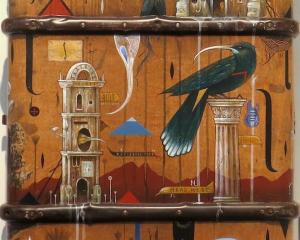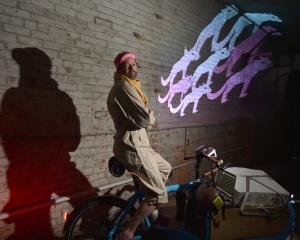Adrian Raeside is nervous about returning to Dunedin. He left in 1970 as a 13-year-old after attending Maori Hill School.
"It's been a long, long time; nearly 40 years now. I've come back almost as a tourist. I feel like a passenger pressing my nose against the window," he says.
"I have been a bit nervous about it, but it's all been very positive. I have a lot of memories here, although everything looks smaller than I remember.
"I remember standing at the Dunedin Railway Station when I was a boy and the big steam trains and the smell of smoke and steam. It was tremendous," he says.
"It's nice coming back and remembering things like that. I guess, at heart, I'm still a Dunedin boy."
Raeside left Dunedin when his late father, DSIR scientist James Raeside, was transferred to Christchurch and then Wellington, before the family emigrated to Canada via England.
"We lived for a time in a house on Royal Terrace. I've been visiting the houses we lived in. But, I don't really know anyone in the city anymore, except an old schoolteacher, Beth Larkin, who lives on City Rd.
"We used to have a small cottage near Otakou which, at that time, could only be reached at low tide by driving over the sand. Needless to say, the family car eventually disintegrated in a pile of rust. I'm sure there is a decent road through there by now."
He now lives in Whistler, British Columbia, about two hours north of Vancouver.
Raeside (51) is a Dunedin boy made good. Although, he's taken a roller-coaster ride to get there.
He's worked at various jobs over the years, from loading grain ships in Thunder Bay to surveying on Canada's West Coast.
"I just did odds and sods to keep myself going. But, all the time I was sending out cartoon samples to newspapers and getting rejection slips back.
Every day, there would be a rejection slip in the letterbox. I finally sold my first cartoon for $2 in 1978 and I built from that."
He has now been the editorial cartoonist for the Victoria Times Colonist for 30 years and his cartoons appear in more than 200 newspapers and magazines worldwide, from the Los Angeles Times to Newsweek in Japan.
"I do about four or five editorial cartoons a week, on things like politics and social satire."
His comic strip, The Other Coast, appears in more than 350 newspapers worldwide.
"The comic strip is about environmentalists. It sends up environmentalists who live on the west coast of North America and shows what hypocrites they are.
"There's been so much destruction in BC because of clear-cut logging," he says.
"It's a parody of life, sort of. It's a place where dogs get hooked on nicotine gum, oilmen drill for coffee and environmentalists do their bit to save the depleted oceans by sharing the shark fin soup."
Raeside is passionate about his craft.
"I love newspapers. There's something about opening up the paper in the morning. It's like Christmas. You never know what's going to be in it," he says.
"Wherever you are in the world, you can go to the editorial pages and find out how people think about things. It's a window into a community.
"Being a cartoonist is an addictive profession, because you get used to daily deadlines. It's a strange job, too, in that you're always striving to do better but, no matter how much time you spend on it, it wraps fish the next day.
"If you're lucky, it might end up under a fridge magnet or on a cash register. But, it's a profession that's dying out.
"There's less space in newspapers for comic strips now and there are less papers than there used to be. The heyday is over.
"People are not subscribing to newspapers like they used to.
"My worry is that a whole generation are growing up with a cellphone, but not reading the paper. But there's always going to be that hard core of newspaper readers.
"A newspaper has to be all things to all people, but it never can be. Editorial cartoons should focus on what affects the readers. You try to keep that connection.
"Your guy [Garrick Tremain] is bang on. It's the quintessential editorial cartoon. It's funny and provides a point and it's able to do it in one panel," he says.
"There must be something about Dunedin, because David Low was from Dunedin and he was a very, very good cartoonist."
Low was born in Dunedin in 1891 and had a stellar career in England with publications such as Punch. He was knighted in 1962, a year before his death in 1963.
"I think New Zealanders are much more satisfied with their lives than North Americans are," Raeside muses.
"New Zealand is a hidden oasis where the troubles of the world don't wash ashore. It's sustainable and green and has a terrific reputation. Everyone wants to go there. New Zealand fits well into the Canadian psyche," he says.
"New Zealand humour is more sophisticated than in North America. There are less taboos here. You couldn't do a cartoon about a lapdance in the US, but you could here. America is much more conservative than New Zealand."
In 1988, he founded an animation company which produced cartoons based on characters such as Jim Henson's Muppets for Turner Broadcasting and the Children's Television Workshop.
"I lost my shirt on that one," he grins, without a flicker of regret.
It's impossible not to like Raeside. Despite his success, he is still a Dunedin boy.
He has also written 13 books, including an irreverent history of Canada, There Goes the Neighborhood, The Demented Decade, 5 Twisted Years and the Dennis the Dragon series of children's books.
Raeside is working on his latest book, Return to Antarctica, which is an account of his grandfather's role in the 1910 Scott expedition to the South Pole.
The book will be published by J.W.Wiley and Sons next year, to mark the centenary of the expedition.
"I've always wanted to return to New Zealand, but the demands of daily deadlines always got in the way. With this book project, I finally have an excuse to visit and see the country again," he says.
"It's my fourteenth book, but my first serious history book. I'm following in my grandfather's footsteps and it will be about my experiences, with a few illustrations.
"My grandfather, Sir Charles Wright, and two great-uncles, Griffith Taylor and Sir Raymond Priestley, all went on the Scott expedition to the South Pole and I'm retracing their journey from New Zealand to Cape Evans," he says.
"I'm trying to put together a book to tell the true story of what really happened. Scott myths have been perpetuated by the British over the years.
"There was so much written that was supposition."
Sir Charles was the physicist and glaciologist on Robert Falcon Scott's ill-fated 1910-1913 expedition to reach the South Pole.
Raeside has all of his grandfather's journals, letters and artefacts from the historic expedition.
Scott led the ill-fated Terra Nova expedition to the South Pole in mid-January, 1912, but on arrival discovered a tent left by Norwegian explorer Roald Amundsen and his team.
Inside the tent was a note informing them that Amundsen had reached the pole on December 14, 1911, beating Scott's party by 35 days.
On their return journey Scott and his four comrades perished through exhaustion, hunger and extreme cold.
Raeside left Lyttelton aboard the Kapitan Klebnikov on the 26-day voyage to Cape Evans last Saturday.
The last thing he did in Dunedin was make plans should he suffer a similar fate to the Scott expedition explorers.
"If I should be tossed off the ship and wash ashore at Portobello, please make sure I'm buried with a bottle of single malt," he insisted.












![... we all become all of these things [installation view] (2025), by Megan Brady.](https://www.odt.co.nz/sites/default/files/styles/odt_landscape_small_related_stories/public/story/2025/03/1_we_all_become_all_of_thes.jpg?itok=nicA_yAm)